Key takeaways:
- Oysters possess over 100 varieties, with distinct flavors shaped by their region, seasonal availability, and environmental factors.
- Quality of oysters is influenced by water conditions, salinity, harvesting methods, and age, all crucial for enhancing overall taste.
- Creating a balanced oyster platter involves a mix of varieties, thoughtful presentation, and complementary accompaniments to elevate the dining experience.

Understanding oyster varieties
When diving into the world of oysters, it’s fascinating to discover that there are over 100 varieties, each with its distinct flavor profile and texture. Personally, I remember the first time I tasted a Kumamoto oyster; it was a revelation. The sweet, buttery taste was unlike anything I had encountered before. Have you ever experienced a flavor that simply transported you to another place? That’s what these oysters can do.
Take the Eastern oyster, for example. They are larger and have a briny, bold flavor that truly represents their coastal waters. It’s interesting how the location affects their taste. The day I hosted an oyster tasting, I presented both Eastern and Pacific oysters side by side, and my guests were shocked at how different they were, despite both being from the same ocean. Doesn’t it make you wonder how something so simple can yield such diverse experiences?
Additionally, I’ve come to appreciate how the time of year impacts the oysters’ flavors as well. For instance, I learned that oysters are “in season” during the colder months, which gives them a fresher, fuller taste. The first time I purchased oysters in winter, I was astonished at the plumpness and richness of their meat. Have you ever tasted something and thought, “Wow, this is at its peak”? That’s the magic of understanding oyster varieties and how they thrive throughout the seasons.
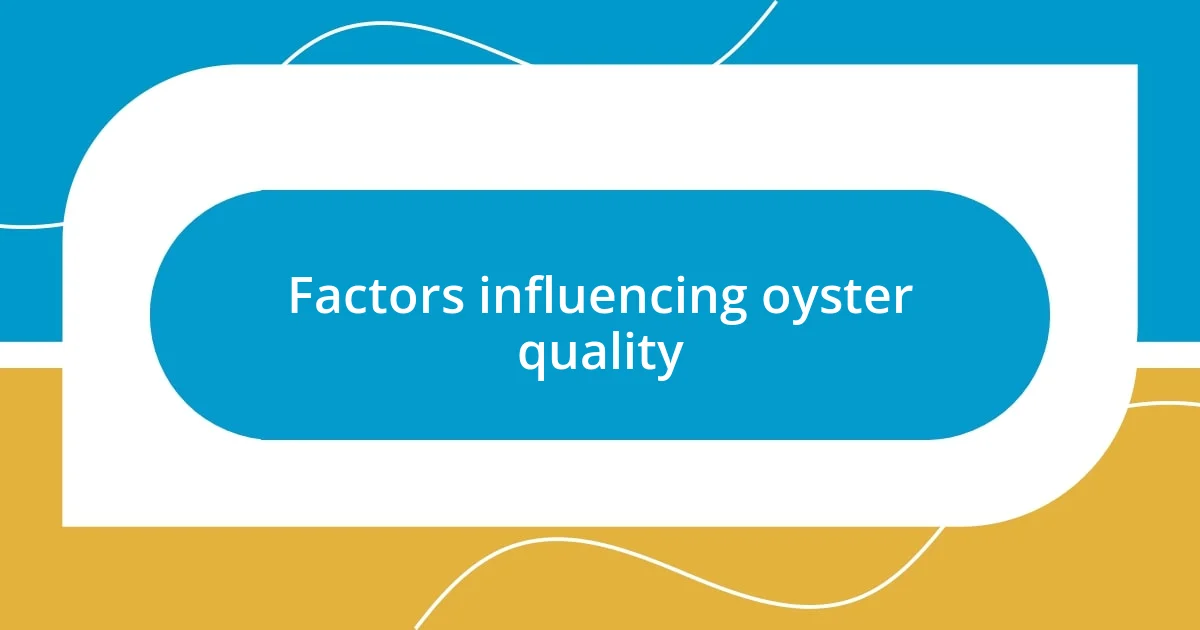
Factors influencing oyster quality
The quality of oysters can be heavily influenced by several factors, and understanding these can make all the difference in the selection process. Water temperature, salinity, and environmental health are crucial. For instance, I once visited a farm in the Pacific Northwest, where I watched the farmers closely monitor the salinity levels. They explained how this balance directly impacts the oysters’ taste. It was enlightening to see the connection between the environment and flavor on the platter.
Here are some key factors that influence oyster quality:
- Water Quality: Clean, unpolluted waters lead to healthier oysters.
- Salinity: The salt level in the water can enhance the taste and texture.
- Harvesting Method: Oysters harvested by hand typically maintain their quality better than those collected en masse.
- Time of Year: Seasonal variations can affect oyster plumpness and flavor, especially in colder months.
- Oyster Age: Younger oysters tend to have a more delicate flavor compared to older, more robust varieties.
I often find myself thinking about these factors when curating an oyster selection for a gathering. It’s like putting together a puzzle, where each piece significantly contributes to the end experience. The excitement of sharing this knowledge with friends as they taste a carefully chosen selection is something I always look forward to.
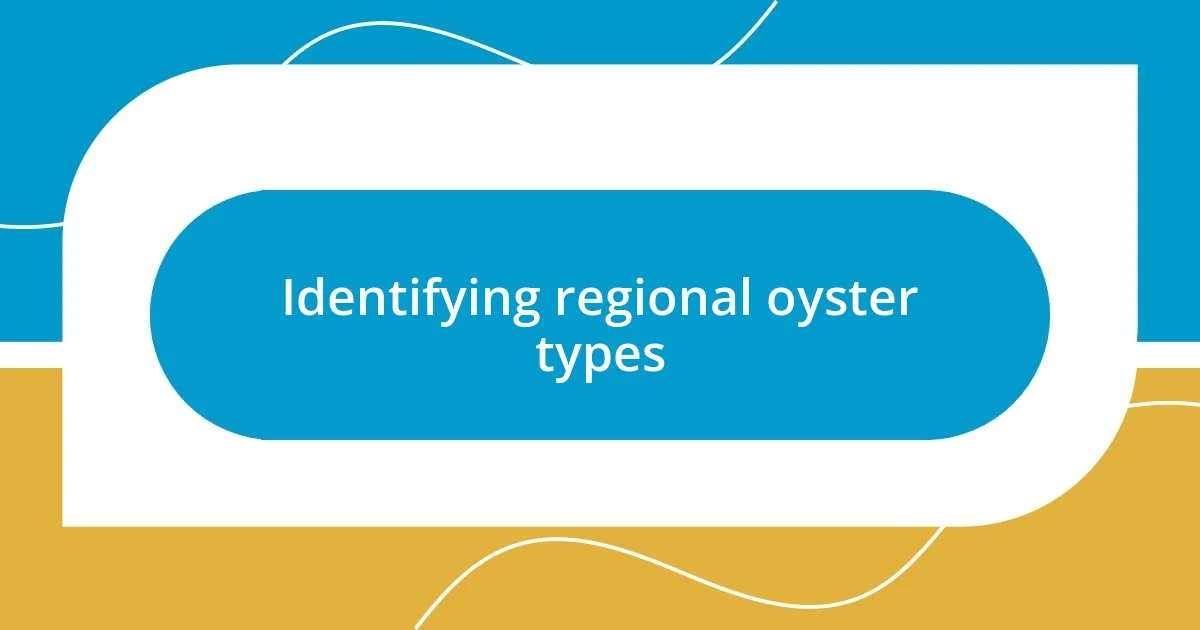
Identifying regional oyster types
The regions where oysters thrive significantly shape their unique characteristics. For instance, I’ll never forget the time I visited the Chesapeake Bay. The moment I arrived, I could immediately sense the rich history and tradition that surrounded their oysters. They have this sweet, buttery flavor, unlike those I had encountered elsewhere. Each bite was like a little piece of the bay itself—just think about how terroir, or the environmental factors that affect crops, applies to oysters!
Similarly, my experience with Pacific oysters, particularly from the West Coast, opened my eyes to a completely different world. They possess a crisp, briny flavor, reminiscent of the ocean spray that surrounds them. I can recall a warm summer evening spent slurping down these Pacific gems while gazing at the sunset; it was pure bliss. It’s these regional distinctions that not only help in identifying oyster types but also create lasting memories tied to their consumption. Isn’t it intriguing how a simple gift from the sea can tell such a rich story?
I find that when selecting oysters, understanding these regional varieties offers a deeper appreciation for what makes them special. From the Clean waters of the Gulf of Mexico producing the creamy and slightly nutty Gulf oyster to the distinctively sweet and mineral-forward Kumamoto from Japan, each variety speaks to the place of its origin. For me, it’s not just about taste; it’s about the experience and story behind each oyster type, sparking my desire to educate others about their journey from sea to plate.
| Oyster Type | Region | Flavor Profile |
|---|---|---|
| Eastern oyster | Atlantic Coast | Briny, bold, sweet |
| Kumamoto | Pacific Coast (Japan) | Buttery, sweet, complex |
| Pacific oyster | West Coast USA | Crisp, briny, clean |
| Gulf oyster | Gulf of Mexico | Creamy, nutty, mild |
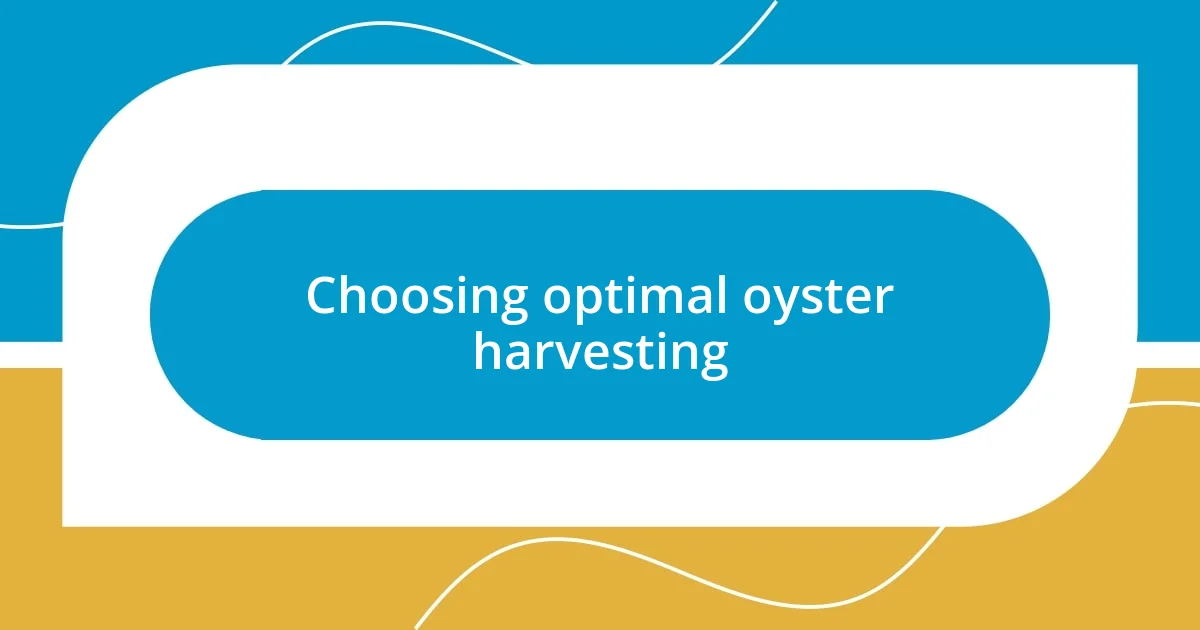
Choosing optimal oyster harvesting
Choosing the right time for oyster harvesting can be a game-changer. I recall a chilly December morning when I joined a local fisherman at dawn. He emphasized how the cooler water during winter months leads to oysters being plump and full of flavor. It was eye-opening to see firsthand how nature’s cycles can dictate the quality of what ends up on our plates.
Harvesting methods also play a crucial role in ensuring optimal quality. Once, while volunteering at an oyster farm, I was amazed by the care they took in hand-harvesting their catch. Each oyster was gently pried from its bed, which not only preserved its meat but also maintained its delicate shell. When I tasted those oysters later, I could tell how this method enhanced their flavor. Have you ever noticed how the care taken in harvesting can elevate the overall eating experience?
Additionally, considering water quality can’t be stressed enough. I remember tasting oysters from a region that was under a temporary pollution advisory. The difference was palpable; they lacked the clean, refreshing taste I had experienced in pristine waters. This made me realize that choosing oysters from clean, monitored environments not only supports marine health but also offers the best flavor for my selection. It’s a wonderful reminder that what we eat is deeply connected to the health of our oceans.
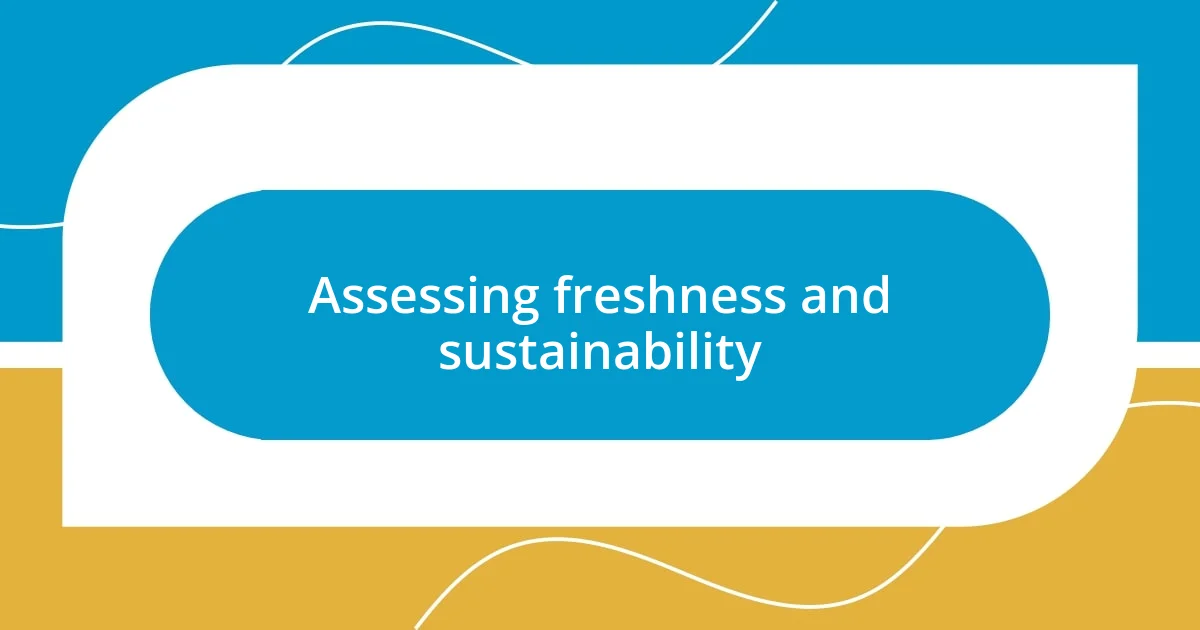
Assessing freshness and sustainability
When it comes to freshness, I always rely on my senses. On one occasion, I was at a bustling fish market, and I noticed an oyster that still had a slight shimmer—this was a telling sign of its freshness. When I cracked it open, the briny burst instantly ignited my taste buds, reinforcing my belief that fresh oysters truly deliver the best flavor. Have you ever considered how the look and feel can reveal an oyster’s journey before it reaches your table?
Sustainability is another crucial aspect that shapes my oyster selection. I’ve found that knowing the source of the oysters speaks volumes about their ecological impact. While attending a seafood festival, I spoke with local farmers who practiced responsible aquaculture. Their commitment to preserving natural habitats made me feel confident about my choices. Do you see how supporting sustainable farms not only benefits the environment but also ensures that we can enjoy oysters for generations to come?
I also pay attention to certifications, like the Marine Stewardship Council label, when browsing options. One time, I chose oysters that were sustainably harvested, and it felt rewarding to know I was making an ethical choice. They tasted just as amazing as the ones from conventional sources but came with the added bonus of peace of mind. It’s fascinating how a small label can reflect such a big commitment to our oceans—don’t you think that small actions can make a significant difference?
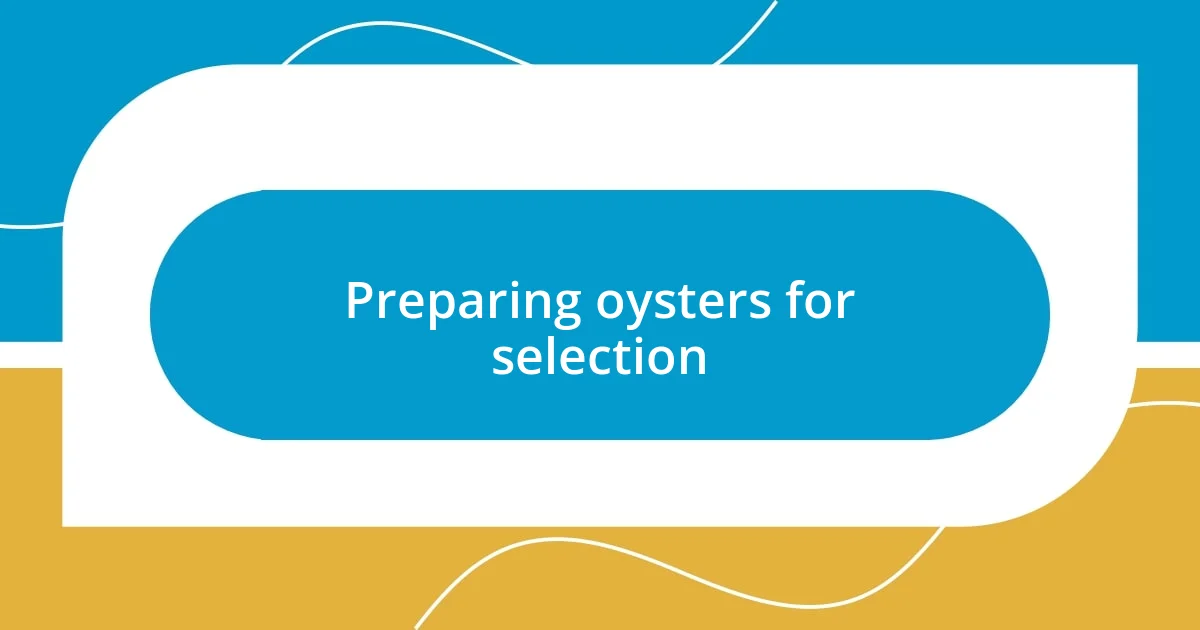
Preparing oysters for selection
Preparing oysters for selection goes beyond mere aesthetics; it’s about creating a mindful experience that ultimately enhances enjoyment. I remember the time I carefully inspected a batch of fresh oysters at a local stall. As I held each shell in my hands, I felt a sense of connection with the ocean. The iridescent colors reflecting the light reminded me of sunset views over the calm sea. Doesn’t appreciating the visual beauty of oysters elevate the entire selection process?
Next, I prioritize an inspection of the shells. I’ve found that fully closed shells are a good sign of liveliness, while any that are slightly open indicate the need to give them a gentle tap to check for tightness. A memorable experience from a seafood market taught me that one stubborn oyster with a cracked shell was not worth the risk; it tasted flat and lackluster compared to the vibrant ones I ultimately chose. Don’t you feel like your choices are influenced by those little moments of discovery?
Finally, it’s essential to note the fragrance before I even consider making a selection. I distinctly recall standing over a display where the sweet, briny scent transported me right to the saltwater coasts. In contrast, oysters that had a faint, unpleasant aroma were quick to dissuade me. It’s fascinating how our senses can guide us—do you ever let your sense of smell drive your decisions when it comes to choosing seafood?
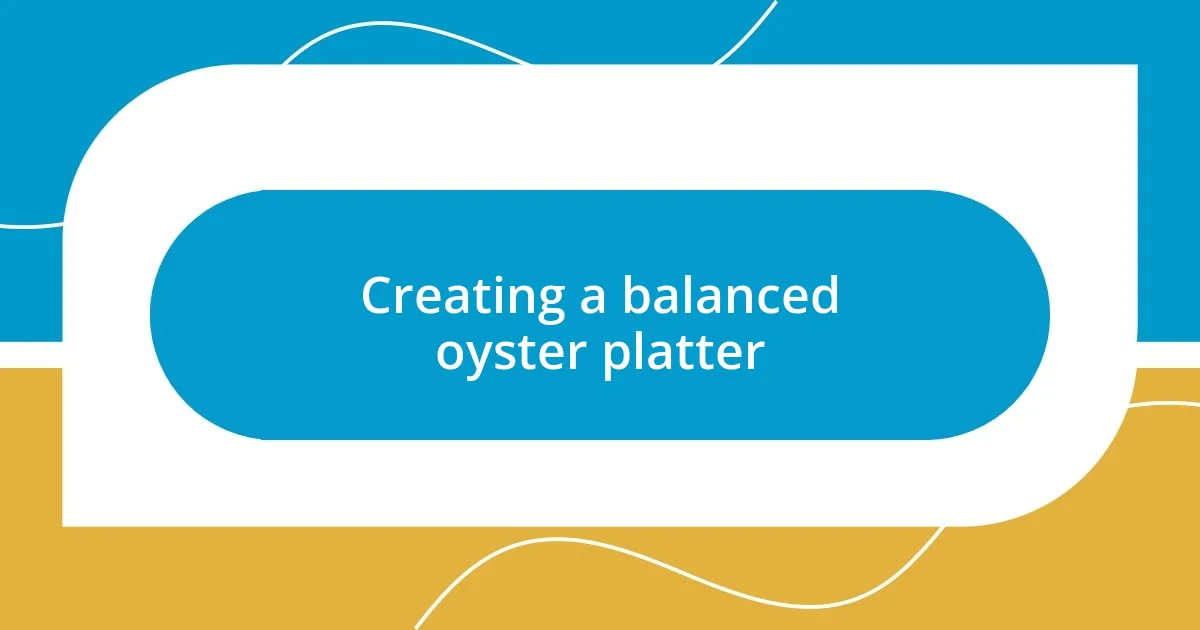
Creating a balanced oyster platter
Creating a balanced oyster platter is all about variety and harmony. I often start by including a mix of oyster types, like Kumamoto and Atlantic Coast oysters, to play with different flavors and textures. Each variety brings its own unique profile—Kumamotos are sweet and creamy, while the Atlantic oysters can offer a brinier, more robust bite. How do you think introducing these flavor contrasts might delight your guests?
Presentation also plays a vital role in curating the perfect platter. I love laying my oysters on a bed of crushed ice for a touch of elegance, and I make sure to arrange them by size and species. Once, at a dinner party, I noticed how the glistening ice and arranged shells sparked conversation among my friends—everyone was eager to dive in! Have you ever noticed how an artful presentation can enhance not just the dining experience but also the anticipation?
Adding thoughtful accompaniments is the final touch that elevates an oyster platter. I typically include classic mignonette sauce, lemon wedges, and even a spicy cocktail sauce for a kick. At a recent gathering, I served a homemade mignonette infused with shallots and a hint of champagne vinegar—it was such a hit that everyone was asking for the recipe! Don’t you find that these small additions can transform something simple into a memorable feast?














